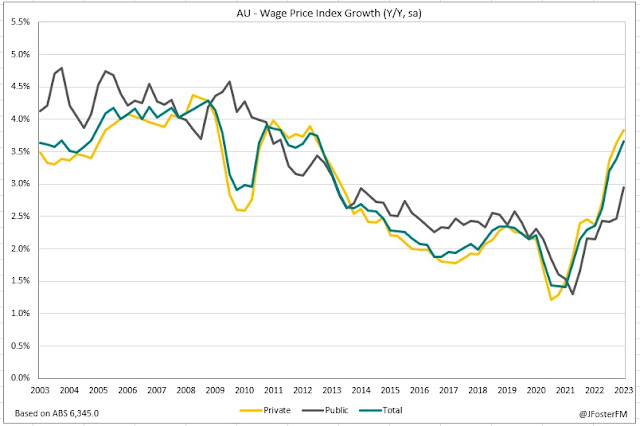Australian wages growth lifted at its fastest pace in a decade rising by 3.7% over the year to the March quarter. Strong labour market conditions continued to underpin wages growth, which was also supported by new enterprise agreements and public sector wage policies coming into effect. But wages growth still remains in the range the RBA assesses to be consistent with the inflation target.
Wage Price Index — Q1 | By the numbers
- The headline WPI (total hourly rates of pay ex-bonuses) increased by 0.8% in the quarter, below the 0.9% pace expected and down from the previous quarter (0.9%). Annual growth lifted to 3.7% from 3.4% (revised from 3.3%).
- Private sector wages lifted by 0.8% quarter-on-quarter to an annual pace of 3.8% (from 3.6%).
- Quarterly growth in public sector wages increased at its fastest pace in a decade rising by 0.9% to be up by 2.9% through the year (from 2.5%).
Wage Price Index — Q1 | The details
ABS analysis reports that individual agreements and enterprise agreements contributed in roughly equal measure to wages growth in the March quarter. Strong labour market conditions are the main factor behind wage increases in jobs covered by individual agreements. Enterprise agreements recorded a larger than usual contribution to wages growth for this time of year, reflecting newly negotiated agreements coming into effect and a lifting of some public sector wage caps.
The share of jobs (in the private sector) that received a pay increase in the March quarter was 14%, which is in line with the experience over the years prior to the pandemic. Outside of the pandemic period, the largest share of pay increases in Australia has typically occured in the September quarter of each year. The average pay increase that went through in Q1 was elevated at 4.3%. That was up from a 4% increase in the previous quarter but in line with the rise in Q3 2022.
There remains upward pressure on wages growth in response to the strong labour market. The overall trend from the past couple of years is still intact; the share of jobs receiving small to modest pay increases is declining while the share of jobs receiving larger pay increases is rising.
There are signs, however, that wage pressures are losing some momentum. Growth in the WPI on both a 3- and 6-month annualised basis was 3.4% in the March quarter, with both measures down from their recent highs and running below the year-ended pace (3.7%). That indicates base effects are adding to the pace of wages growth. If that interpretation is correct, wages growth could struggle mechanically to rise much further as the year progresses, even if the labour market remains strong. It is worth highlighting that the RBA recently downgraded its assessment for the peak in wages growth to 4% from 4.2%.
Across the industries, wages growth ranges from 2.9% at the low end to 4.4% on the high end (see summary table above). Much of the RBA's focus has turned to wage pressures in the services sector. A weighted average of industries in household services indicates wages growth in that sector is at a decade high but running below 3.5%. There is more pressure coming through in business services where wages growth is close to 4%, though that too is only getting back to its pace from a decade ago, and it has risen only gradually over the past two quarters.
Wage Price Index — Q1 | Insights
The RBA made a tilt in the hawkish direction at the May meeting, surprising markets with a rate hike citing risks around persistent inflationary pressures. That was despite its assessment that wages growth was not a constraint to a return to 2-3% inflation, based on an outlook where productivity gains are reestablished. As alluded to above, the RBA recently downgraded its outlook for wages growth, to 3.8% in June and then 4% by year-end. But based on today's report, wages growth would need to pick up for those forecasts to be met. For example, the WPI in Q2 would need to rise by 1% for the annual pace to lift from 3.7% to 3.8%. Nevertheless, in its hawkish mindset, the RBA may draw more attention to other aspects of the report such as the rising share of jobs receiving larger wage rises or the elevated pace of private sector wage increases.









